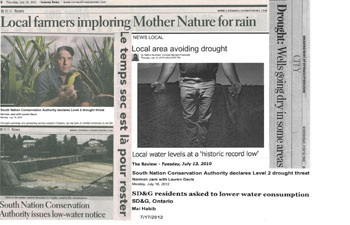 In recent years, as a result of changing climatic conditions, the South Nation watershed has been experiencing more severe drought conditions than has historically been observed. Most apparent in 2012, Eastern Ontario experienced an extended period of low rainfall and high temperatures. As a result, the watershed had one of the lowest surface water levels recorded in the last 50 years. Studies on changing weather patterns indicate that low water levels may become more common, potentially compounded by the province’s steadily increasing demands for water and by climate change. This could have an intense effect on Canada’s freshwater resources including changes in flow, evaporation rates, and amount/timing of meltwater discharge. Consequences of this could include compromised ecosystem health, particularly of aquatic and riparian species directly affected by low-water stream conditions.
In recent years, as a result of changing climatic conditions, the South Nation watershed has been experiencing more severe drought conditions than has historically been observed. Most apparent in 2012, Eastern Ontario experienced an extended period of low rainfall and high temperatures. As a result, the watershed had one of the lowest surface water levels recorded in the last 50 years. Studies on changing weather patterns indicate that low water levels may become more common, potentially compounded by the province’s steadily increasing demands for water and by climate change. This could have an intense effect on Canada’s freshwater resources including changes in flow, evaporation rates, and amount/timing of meltwater discharge. Consequences of this could include compromised ecosystem health, particularly of aquatic and riparian species directly affected by low-water stream conditions.
In an effort to help mitigate socio-economic and ecosystem stress associated with low-water conditions, the Ontario Low Water Response program aims to ensure provincial preparedness; assist in coordination; and support local response in the event of a drought. The goal of the project is to identify areas of the watershed that would be most vulnerable to adverse socio-economic and ecological impacts as a result of shortage of water and to make recommendations for adaptation.
We will present a report on these recommendations and corresponding information to the Water Response Team and Board of Directors by June 2014. Findings and recommendations at this time will contribute to improving drought stress management in a changing climate.

